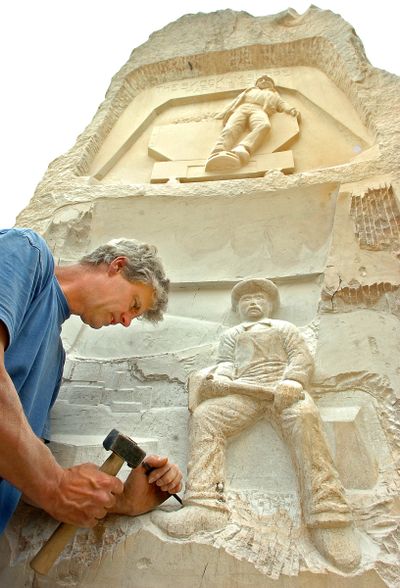Miners’ story set into stone
Sculpture commissioned for town’s centennial

WILKESON, Wash. – Paul Keeslar likes to believe the 50-million-year-old sandstone block had been waiting for him.
More than a year ago, he saw it in the yard of the Wilkeson Sandstone Quarry among a jumble of rocks, large and small. He was looking for a chunk of sandstone for his Wilkeson Centennial sculpture.
“It was perfect,” said the 47-year-old Yelm artist, who was chosen from among four sculptors to create the monument for the town’s 100th birthday, which will be celebrated next month.
The 18-ton stone – more than 4 feet wide and 15 feet tall – was cut from a ridge of stone formed by a river that fed into the sea that became Puget Sound. Chuck Nelson, owner of the quarry, donated the rock.
Keeslar recently put the finishing touches on the two relief panels cut into the stone, which is now ready to be moved to town and set up near Wilkeson City Hall.
The top panel depicts a miner leaning on a coal car coming out of the Skookum Slope mine. The bottom one shows a stonecutter sitting under a tent awning on the face of the Wilkeson quarry.
The $25,000 piece was paid for by local fundraising and two $10,000 grants, one from the Washington Heritage Capital Projects Grant program and one from King County.
Keeslar said his idea for the sculpture was to marry the histories of coal mining and sandstone quarrying in the small foothills town, once the center of the mining boom in northeastern Pierce County.
He took the images from historic Wilkeson photographs.
“The actual Skookum Slope mine is about 1,000 feet away,” he said, pointing into the tangle forest to the west. The entrance still is visible with the name of the mine etched into cement.
Still alive, too, is the miner pictured that day in 1943 and now frozen forever in stone.
Robert Peloli, 86, still lives in Wilkeson. He’s considered the last living coal miner in the gateway town to Mount Rainier National Park.
He’s been up to see Keeslar working and likes what the artist has wrought.
“It’s great,” said Peloli, who admitted the image looks only “somewhat” like him.
The other relief shows an unknown stonecutter with a heavy drooping mustache photographed working the Wilkeson Quarry in 1909.
The stone was set upright in the quarry using its large crane. Carving the sculpture took Keeslar about a month.
His tools – a hammer and various hand chisels along with a pneumatic hammer and chisel – filled a dusty work bag. He also used a power grinder to cut larger slaps out of the stone.
“Sandstone is an abrasive material,” he said. “I have to use carbide steel to work it.”
Using a model set up on an easel, Keeslar measured and marked the relief panels. He started with the figures of the men and moved outward.
He wore a hard hat with ear muffs, protective glasses and an air filter mask to keep the silica dust out of his lungs.
“You have to be patient with it,” he said of his work.
Unlike marble or alabaster that can surprise and reveal the beauty inside, sandstone is what it is, Keeslar said. The artist brings everything to the stone, he said.
The relief panels reveal the pure silver gray, almost white, sandstone inside the rock. Thin lines in the panels aren’t cracks but small seams of coal that underscore the dual themes of the piece, he said.
Fortunately they didn’t appear on a figure’s face, Keeslar said.